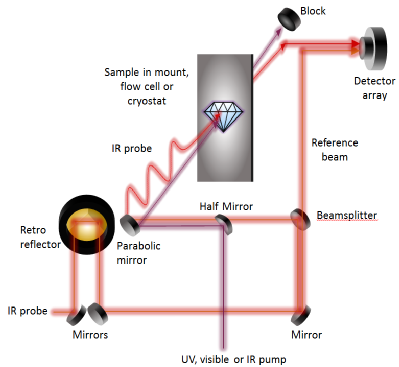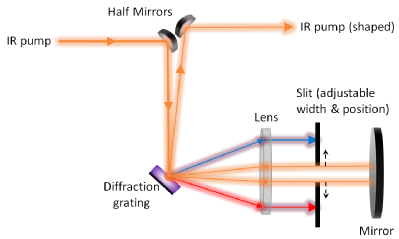Transient Vibrational Absorption Spectroscopy
Transient Vibrational Absorption Spectroscopy is the time-resolved study of the vibrational absorption spectrum of a sample as a function of time, following excitation from a femtosecond laser pulse. By taking a number of these difference absorption spectra over time, a picture of the dynamics of the excited state can be revealed. The experiment is described in more detail below, and shown schematically in Figure 1.

Excitation pulse: The pump pulse can be tuned to any wavelength in the range ~235nm to 10um using an optical parametric amplifier (TOPAS), seeded with a 1 kHz, 40 fs, 800 nm pulse (Ti:Sapphire Spitfire ACE) to create pulse powers of around 10 uJ / pulse. This excitation pulse passes through the sample, to prepare it in an electronically or vibrationally excited state. The pump pulse duration can be varied in the range from ~50fs to ~1ps by means of a simple pulse shaping setup, as shown in Figure 2.
Probe pulse: An IR probe pulse, with a wavelength set to cover the vibrational mode of interest, then passes through the excited sample after some delay time. The probe pulse is a tunable infra-red pulse, also generated with a TOPAS, to give wavelengths in the range of 1-15 microns with a bandwidth of hundreds of nm. The IR beam path is purged by nitrogen to eliminate atmospheric absorption lines.
Delay stage: The time delay is varied by way of a gold retroreflector mounted on a delay stage which increases the path length of the probe pulse. The stage that generates the delay between pump and probe pulses has a travel range of 500 mm with a resolution of 5 microns, reproducible to within 0.5 microns. This corresponds to a maximum temporal window of 3.3 nanoseconds at a resolution of 17 femtoseconds.

Detection: The IR pulse is monitored with Mecury Cadmium Telluride detector array, which also takes dark backgrounds and unpumped spectra to find the difference in absorption following excitation. The IR spectrometer will run for 8-12 hours for a single fill of liquid nitrogen. It consists of two 64 pixel linear arrays, one of which measures a reference beam, for shot-to-shot comparison with the probe beam measured on the other. It can sample the spectra at a rate of 1.9 kHz, thus fully sampling the 1 kHz laser. It possesses three separate gratings only a fully automated turret: 100 lines/mm blazed at 6 microns (7.05 nm/pixel resolution), 75 l/mm at 4 microns (9.4 nm/pixel resolution) and 75 l/mm at 8 microns (9.4 nm/pixel resolution).
Sample environment: Samples can be mounted in a number of ways: in free space; on the cold-finger of a nitrogen or helium cryostat; or in a flow cell.

